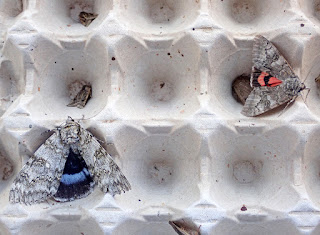Dealing first of all with the period since the last report up to the end of September, there was once again considerable fluctuation in both the number of moths and number of species, varying from 247 of 40 on the 22nd down to 89 of 7 on the 27th but then rising again. There are still plenty of moths out there and those which fly at this time of year are certainly used to much colder conditions than we've had so far. Four of the five expected year-list additions had arrived by the end of the month but I was surprised to have to wait a few more days for Blair's Shoulder-knot because it usually turns up here in late-September:
(22nd) Large Wainscot.
(24th) Clifden Nonpareil.
(28th) Brick.
(29th) Mallow.
 |
| Large Wainscot, Westcott 22nd September |
 |
| Clifden Nonpareil, Westcott 25th September |
The Clifden Nonpareil on the 24th was quite a battered individual so the image above shows another in rather better condition which appeared the following night, along with a Red Underwing which helpfully provides an indication of scale. Migrant-wise, two Vestals and two Rush Veneers appeared again on the 22nd but there were no further obvious visitors from afar beyond the 25th when yet another Rush Veneer put in an appearance (a Silver Y on the 26th is just as likely to to have been a home-grown individual).
Noteworthy on the 23rd was the smallest Dusky-lemon Sallow I can ever remember having seen (wing length 12mm), shown below next to a normal-sized example. Other oddities have included possible second generation appearances by Metalampra italica (29th, last recorded here on 14th August), Anania perlucidalis (22nd, last recorded here on 3rd September) and Cydalima perspectalis (22nd, not seen in the garden since July but thankfully still an uncommon species in this part of Bucks). Of those autumnal moths which over-winter, and as a consequence had already appeared on the year-list much earlier in 2022, Red-green Carpet first appeared on 8th September and Satellite turned up on the 21st, while it was good to see a Tawny Pinion on ivy blossom on the 29th.
 |
| Metalampra italica, Westcott 29th September |
 |
| Dusky-lemon Sallows, Westcott 23rd September |
In keeping with earlier years, since 1st October the actinic light here has been run on its own and, unless a really good migrant night is expected, the garden MV has now been put away for the winter (the actinic was in any case out-performing it on most nights during the second half of September). As a consequence there has been a slight reduction in the overall nightly totals but the species count remained fairly stable in the early to mid-20s until the last two cooler nights when it dropped into the mid-teens again. There have been only two further new arrivals for the garden year-list:
(3rd) Blair's Shoulder-knot.
(7th) Figure of Eight.
 |
| Blair's Shoulder-knot, Westcott 3rd October |
Of the over-winterers, Dark Chestnut first appeared on the 1st (unfortunately caught in a spider's web by our front door light) and was followed by Chestnut on the 4th and Grey Shoulder-knot on the 5th. Tawny Pinion has put in three more appearances to light which is very unusual and means that I've had seven sightings so far in 2022 (three in March/April), the most records ever here in one year. That's in contrast to the usually much more frequent Pale Pinion, of which seven were seen here in the Spring but as yet none this Autumn either on ivy blossom or in the trap. This year's Lunar Underwing count passed 1,000 individuals on the 4th so the final total will be back up somewhere close to where it belongs after a relatively poor showing last year ("only" 764 seen here), although numbers seemed to be dropping off sharply as this period came to an end. Others currently providing reasonable nightly counts are Large Yellow Underwing (occasionally up in the 30s) along with Brick and Beaded Chestnut (both just into double figures), but otherwise numbers of all species are generally in low single digits.
A late example of Aethes smeathmanniana (2nd, my first October record) was worthy of note. Other late-ish sightings have included Lesser Treble-bar (3rd & 7th, not really unusual as I have had previous sightings in the first week of October) and Carcina quercana (4th, my latest date for this species being 1st November). Micros visiting the trap are now few and far between and the only others I've seen here since the beginning of the month are Agonopterix arenella, Amblyptilia acanthadactyla, Emmelina monodactyla, Acleris rhombana, Acleris variegana, Epiphyas postvittana & Eudonia angustea,
 |
| Aethes smeathmanniana, Westcott 2nd October |
Dave Wilton Westcott, Bucks

Hello Dave. Numbers of moths and species are both declining markedly for me in Newton Longville. On Thursday night (6th), I was down to 69 moths of 12 species between my two traps. Lunar Underwings were only 33 of those compared to 193 a week earlier. I have caught no Autumnal Rustic on either of the nights I ran the trap this week: it seems to have a very short season (19th to 29th September for me this year).
ReplyDeleteOne moth on seemingly the "up", though is Cydalima perspectalis: having had occasional individuals over the last month or two, I found five at my LED light on Tuesday night (4th), which is as many as I recorded in the whole of 2020 - the only other year in which I've seen them here.
The first November Moth agg. turned up on 6th, the same night that you found one at Yardley Chase. Unfortunately, mine will remain as the aggregate because it escaped the instant after I had taken a photograph, thus preventing any attempt to examine the abdomen tip.